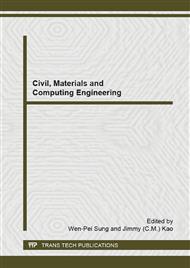p.410
p.415
p.419
p.423
p.427
p.432
p.436
p.440
p.451
Research on the Dynamics of Land Cover Using Mathematical Model
Abstract:
In order to extract information of the Mathematical simulation model for the references of land useplanning decision, it analyzed the land use characteristics in shaoyang district of hunan province, then extracted cultivated land, construction land and rural residential land. Typical relation analysis method and spatial gridding Logistic regression analysis method were used to made quantitative analysis of these three types of driving forces and obtain the main influential driving forces for each land use.The results showed that it can provide scientific support for the formulation of the relevant policies ,the fitting degree of the spatial simulation was rather high(f construction land, rural residential land and cultivated land was 79.45%, 89.35%, 95.35% ), it showed that the model can provide theoretical foundation for the regulation of land-use behavior,also help promote efficient for land use fundamentally.
Info:
Periodical:
Pages:
427-431
Citation:
Online since:
December 2014
Authors:
Keywords:
Price:
Сopyright:
© 2015 Trans Tech Publications Ltd. All Rights Reserved
Share:
Citation:


